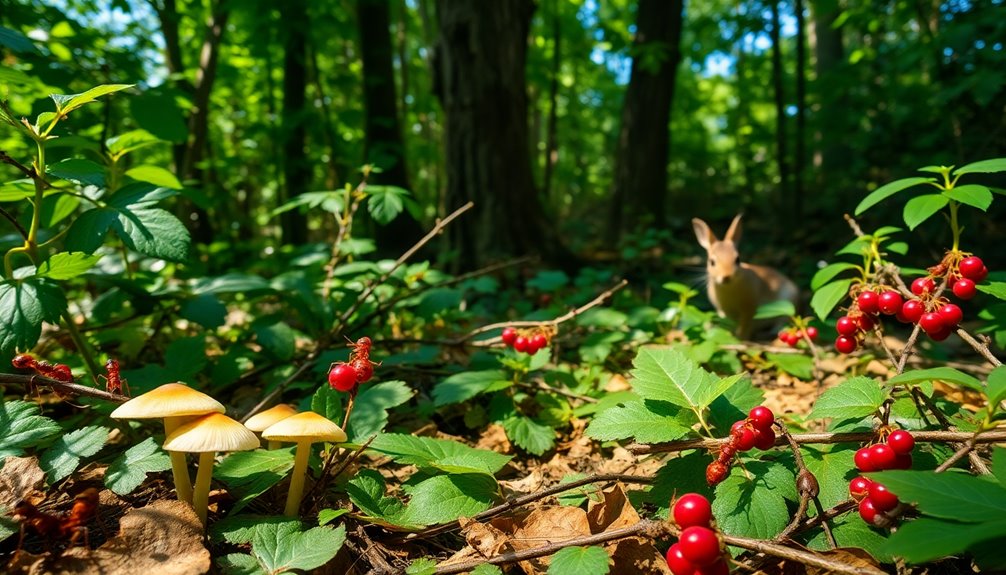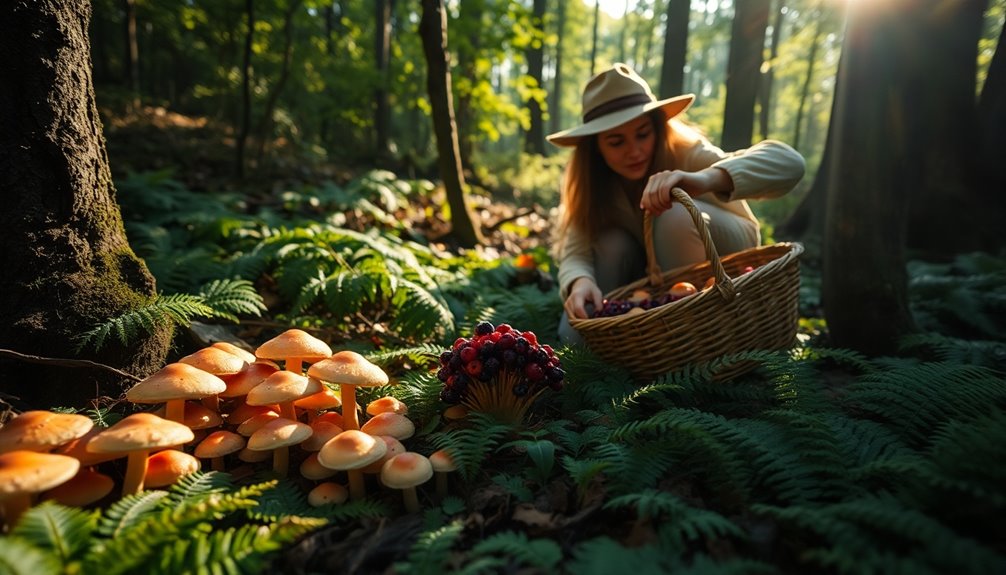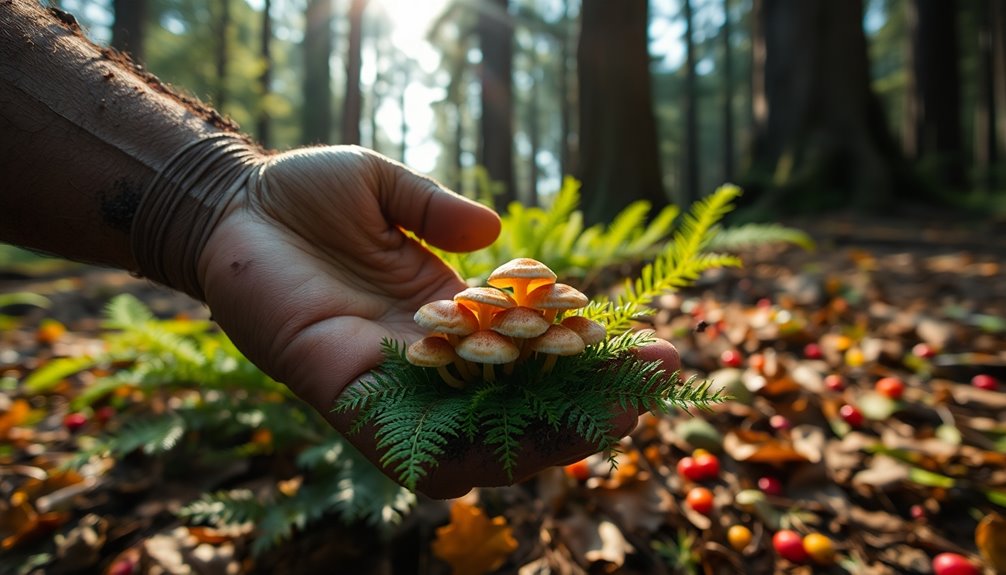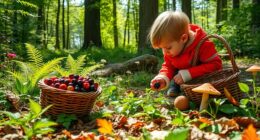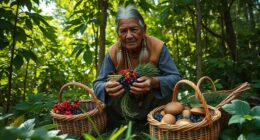Foraging controls population growth by directly impacting resource availability and community dynamics. When resources are plentiful, populations can thrive and reproduce successfully. However, when food sources dwindle, reproductive rates drop, leading to lower population densities. Foraging strategies evolve in response to environmental changes and social structures to guarantee resource sharing, which prevents overpopulation. By maintaining small, mobile groups, populations can adapt and sustain themselves without depleting local resources. This intricate balance of foraging and population dynamics plays an essential role in ecosystem health. If you're curious about specific strategies and effects, there's more to uncover.
Key Takeaways
- Resource availability directly affects population growth, with higher food sources leading to increased reproductive success and larger populations.
- Foraging behavior adapts to energy gain; individuals switch patches when resources dwindle, regulating energy intake and population dynamics.
- Small, mobile foraging societies share resources, preventing overpopulation and ensuring sustainability, which supports stable population sizes.
- Social structures like egalitarian sharing and cultural practices promote cooperation, limiting excess resource accumulation and fostering population stability.
- Environmental changes, such as ocean acidification, can disrupt foraging efficiency, leading to decreased growth and reproduction, ultimately impacting population dynamics.
Foraging and Resource Availability
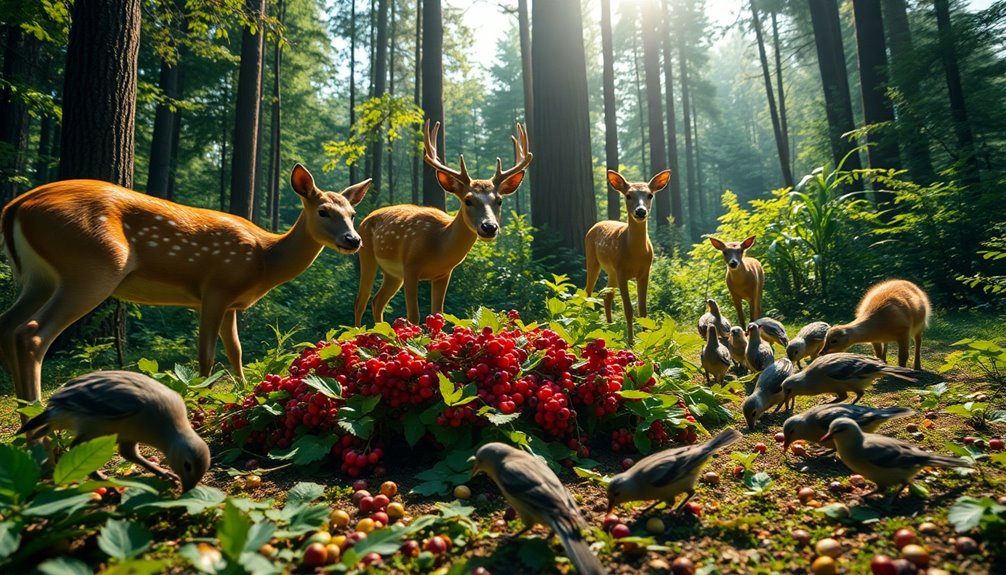
Foragers, whether they're birds hunting for insects or deer grazing in a meadow, are constantly influenced by the availability of resources. Your foraging behavior is directly linked to the abundance of food sources in your environment.
When resource availability is high, you'll likely experience population growth, as energy gain becomes easier, and reproductive success increases. However, when food sources dwindle, your group might face reduced reproductive rates and lower population densities.
According to the marginal value theorem, you'll switch patches when the energy gain from a specific food source diminishes. This adaptability helps regulate not only your own energy intake but also the overall population dynamics within your community.
Additionally, within foraging groups, dominance hierarchies can play a critical role in determining who gets access to the best resources. Some individuals may thrive while others struggle to find enough food, impacting population growth.
Population Dynamics in Foraging Societies
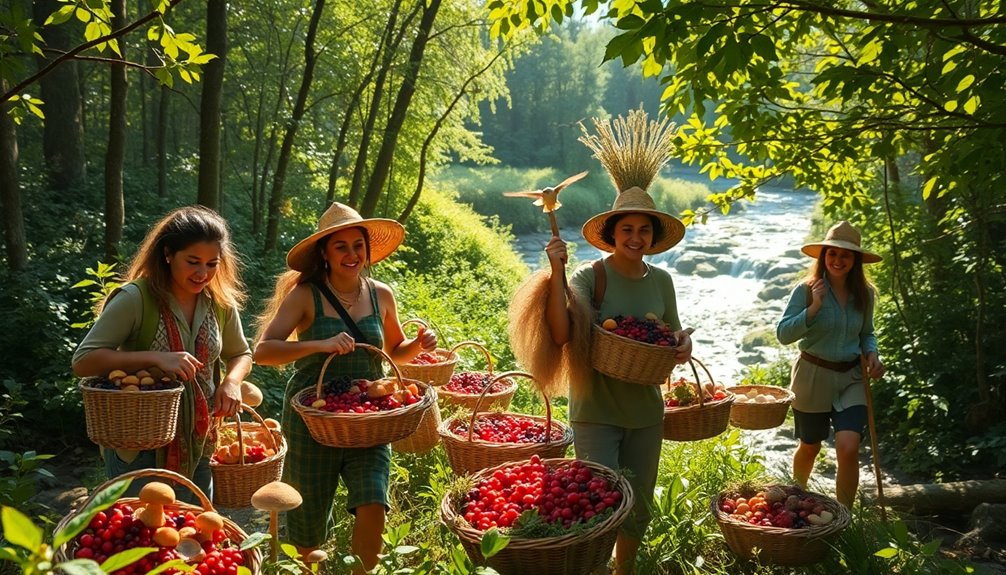
While traversing the challenges of resource availability, you'll find that population dynamics in foraging societies are intricately linked to their unique social structures and mobility patterns. Typically, these societies maintain small population sizes, often between 20 and 50 individuals. This limited size promotes high mobility and resource sharing, effectively controlling population growth.
In foraging communities, reproductive strategies are influenced by the necessity to travel and the availability of food, resulting in longer birth intervals and lower population densities. The egalitarian structure of these societies fosters cooperation and sharing, preventing the accumulation of excess resources that could encourage larger families.
Moreover, the high mobility of foraging groups leads to frequent camp movements, restricting the number of individuals that can be sustained in any given area. Historical evidence shows that as foraging communities face environmental changes or resource scarcity, they adapt their social structures and reproductive strategies, further shaping population dynamics.
This ongoing adaptability highlights the intricate balance between resource availability and population growth in foraging societies, ensuring that they thrive within their ecological limits.
Social Structures and Resource Management
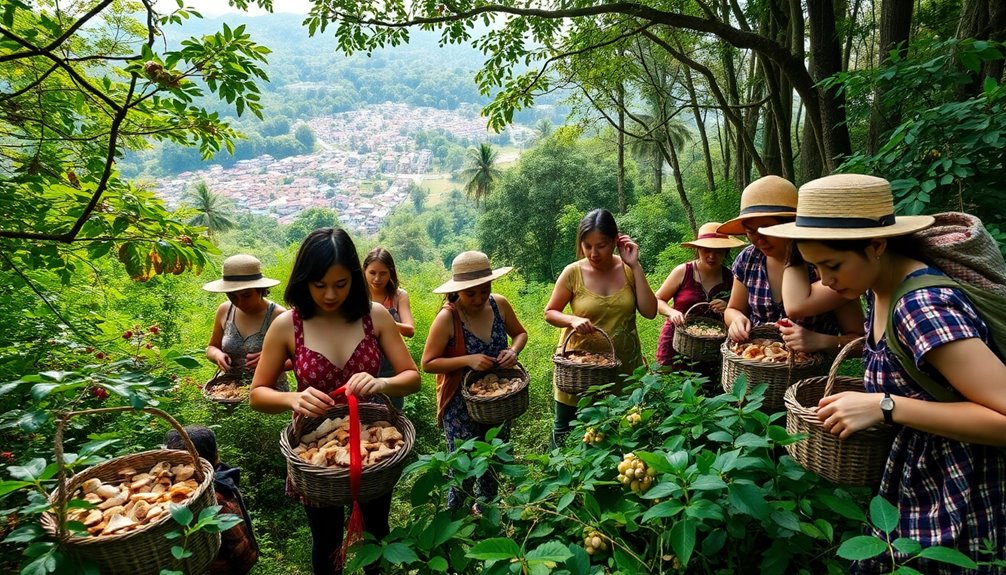
Cooperation is essential in foraging societies, where social structures play an important role in managing resources. These communities often have egalitarian systems that promote sharing, which limits individual wealth accumulation and helps control population growth. With immediate return systems, labor yields quick rewards, supporting smaller populations that can effectively manage local resources.
| Social Structure | Resource Management | Cultural Practices |
|---|---|---|
| Egalitarian sharing | Prevents resource monopolization | Potlatch ceremonies |
| Flexible gender roles | Diverse contributions | Strengthens social ties |
| Extensive ecological knowledge | Broad food sources | guarantees resource stability |
| Low population density | Avoids overexploitation | Reinforces community bonds |
| Adaptation to change | Sustainable practices | Promotes resilience |
In foraging societies, extensive ecological knowledge allows you to utilize various food sources, guaranteeing a stable supply of resources. Cultural practices, like potlatch ceremonies, help redistribute wealth, reinforcing social ties while preventing monopolization. This collective approach not only sustains your community but also controls population dynamics, making foraging societies a remarkable example of how social structures and resource management intertwine to maintain balance within ecosystems.
Environmental Impact on Foraging Behavior

The delicate balance of marine ecosystems is increasingly threatened by environmental changes, particularly ocean acidification (OA). As a result, the foraging behavior of marine organisms is markedly impacted. OA disrupts chemoreception, which is vital for these organisms to locate food effectively. Under acidified conditions, species like N. festivus experience damaged chemoreceptors, leading to longer feeding times and reduced energy intake. This decreased efficiency in foraging can directly affect their overall survival and reproduction.
Research shows that gastropods, for instance, struggle with lower food consumption rates due to OA. Different populations exhibit varied responses, indicating that prior exposure to elevated CO2 levels might mitigate some adverse effects.
This adaptability of shallow-coastal organisms suggests they may have some resilience to fluctuating pH levels, which can influence their foraging strategies. However, prolonged exposure to acidified conditions can still alter population dynamics, as decreased food intake affects growth and reproduction.
Evolutionary Adaptations and Foraging Strategies
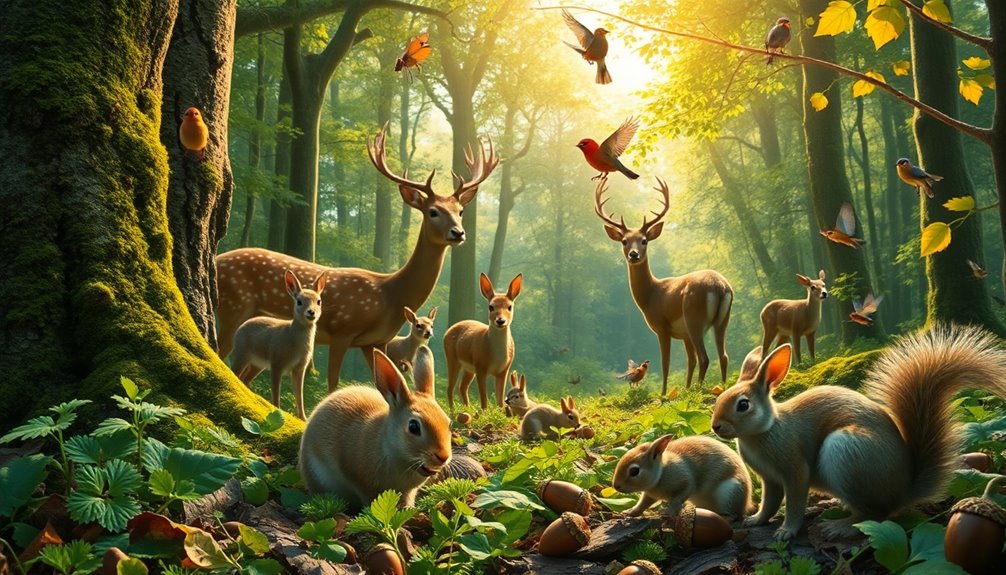
Environmental changes, like ocean acidification, push marine organisms to adapt their foraging strategies for survival.
You'll find that foraging strategies, such as sit-and-wait and active foraging, help species manage energy expenditure based on prey availability. This adaptation directly influences population growth by optimizing resource acquisition.
The bimodal distribution of foraging behaviors among species showcases how evolutionary adaptations can lead to distinct strategies that minimize competition and enhance survival rates.
By employing various foraging models, organisms can adjust their tactics to efficiently exploit available resources, which is essential in fluctuating environments.
Optimal foraging theory suggests that animals make decisions to maximize their net energy gain, impacting their reproductive success and overall population dynamics.
When you consider behavioral ecology, you'll see that plasticity in foraging—like adjusting strategies based on prey behavior—plays an important role in maintaining population sizes.
Frequently Asked Questions
How Does Foraging Control Population Growth?
Foraging controls population growth by balancing resource availability.
When you forage, you focus on finding food, which means your group doesn't overconsume. If food is plentiful, your population can thrive, but scarcity makes reproduction harder.
You and your community prioritize sharing and sustainable practices, creating a stable environment. This way, you avoid the pitfalls of rapid growth and guarantee that your resources can regenerate, maintaining a healthy population size.
Why Do Foragers Have Low Rates of Population Growth?
Imagine a delicate balance, like a tightrope walker carefully choosing each step. Foragers maintain low population growth rates because they rely on limited resources.
You'll see their small communities, usually 20 to 50 individuals, prioritize sharing over accumulation. As you observe their lifestyle, you'll notice how travel needs and environmental factors further restrict family size.
With natural cycles guiding their movements, they guarantee sustainability, keeping their populations in harmony with the ecosystem.
What Is the Explanation of Foraging?
Foraging is all about how you search for and gather food from wild resources. It involves making choices about where to look, based on the availability of habitats and prey.
You might decide to sit and wait for food or actively hunt, depending on what's around. Your success in foraging often hinges on social interactions with others, as working together can enhance your chances of finding and sharing resources effectively.
What Is Optimal Foraging Theory and How Does It Impact an Organism's Behavior?
Ideal Foraging Theory (OFT) explains how you, as an organism, make decisions about finding food. You weigh the energy you spend searching for resources against what you gain from consuming them.
When food availability decreases, you switch to new locations, maximizing your energy efficiency. By staying in a patch until the average energy gain equals the overall rate, you enhance your foraging strategy and improve your chances of survival and reproduction.
Conclusion
In the grand dance of nature, foraging isn't just about finding food; it's a key player in controlling population growth. Like a conductor guiding an orchestra, resource availability shapes societies and their dynamics. When you understand how social structures manage resources and adapt to environmental changes, it's clear that foraging strategies are essential for survival. Just as the seasons change, so too does the balance of life, reminding us that every choice impacts our world.


